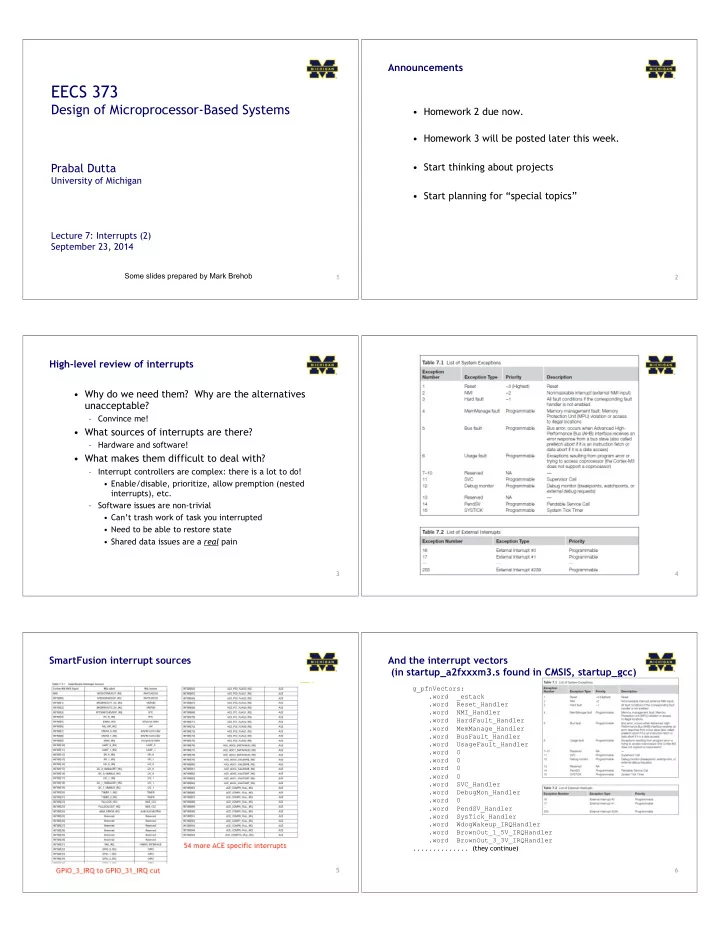

Announcements EECS 373 Design of Microprocessor-Based Systems • Homework 2 due now. • Homework 3 will be posted later this week. • Start thinking about projects Prabal Dutta University of Michigan • Start planning for “special topics” Lecture 7: Interrupts (2) September 23, 2014 Some slides prepared by Mark Brehob 1 2 High-level review of interrupts • Why do we need them? Why are the alternatives unacceptable? – Convince me! • What sources of interrupts are there? – Hardware and software! • What makes them difficult to deal with? – Interrupt controllers are complex: there is a lot to do! • Enable/disable, prioritize, allow premption (nested interrupts), etc. – Software issues are non-trivial • Can’t trash work of task you interrupted • Need to be able to restore state • Shared data issues are a real pain 3 4 SmartFusion interrupt sources And the interrupt vectors (in startup_a2fxxxm3.s found in CMSIS, startup_gcc) g_pfnVectors: .word _estack .word Reset_Handler .word NMI_Handler .word HardFault_Handler .word MemManage_Handler .word BusFault_Handler .word UsageFault_Handler .word 0 .word 0 .word 0 .word 0 .word SVC_Handler .word DebugMon_Handler .word 0 .word PendSV_Handler .word SysTick_Handler .word WdogWakeup_IRQHandler .word BrownOut_1_5V_IRQHandler .word BrownOut_3_3V_IRQHandler .............. (they continue) 5 6
Interrupt handlers Pending interrupts The normal case. Once Interrupt request is seen, processor puts it in “pending” state even if hardware drops the request. IPS is cleared by the hardware once we jump to the ISR. 7 8 This figure and those following are from The Definitive Guide to the ARM Cortex-M3, Section 7.4 In this case, the processor never took the interrupt because we cleared the IPS by hand (via a memory-mapped I/O register) 9 10 Answer 11 12
Interrupt pulses before entering ISR Answer 13 14 15 16 17 18
19 20 21 22 Masking 23 24
The xPSR register layout ARM interrupt summary 1. We’ve got a bunch of memory-mapped registers that control things ( NVI NVIC ) – Enable/disable individual interrupts – Set/clear pending – Interrupt priority and preemption 2. We’ve got to understand how the hardware interrupt lines interact with the NVIC 3. And how we figure out where to set the PC to point to for a given interrupt source. 25 26 1. NVIC registers (example) 1. More registers (example) 27 28 1. Yet another part of the NVIC registers! 2. How external lines interact with the NVIC The normal case. Once Interrupt request is seen, processor puts it in “pending” state even if hardware drops the request. IPS is cleared by the hardware once we jump to the ISR. 29 30 This figure and those following are from The Definitive Guide to the ARM Cortex-M3, Section 7.4
3. How the hardware figures out what to set the PC to So let’s say a GPIO pin goes high - When will we get an interrupt? - What happens if the interrupt is allowed to proceed? g_pfnVectors: .word _estack .word Reset_Handler .word NMI_Handler .word HardFault_Handler .word MemManage_Handler .word BusFault_Handler .word UsageFault_Handler .word 0 .word 0 .word 0 .word 0 .word SVC_Handler .word DebugMon_Handler .word 0 .word PendSV_Handler .word SysTick_Handler .word WdogWakeup_IRQHandler .word BrownOut_1_5V_IRQHandler .word BrownOut_3_3V_IRQHandler .............. (they continue) 31 32 What happens when we return from an ISR? Other stuff: The xPSR register layout 33 34 Example of Complexity: The Reset Interrupt Interrupt types • Two main types – Level-triggered – Edge-triggered 1) No%power% 2) System%is%held%in%RESET%as%long%as%VCC15%<%0.8V% a) In%reset:%registers%forced%to%default% b) RCGOsc%begins%to%oscillate% c) MSS_CCC%drives%RCGOsc/4%into%FCLK% d) PORESET_N%is%held%low% 3) Once%VCC15GOOD,%PORESET_N%goes%high% a) MSS%reads%from%eNVM%address%0x0%and%0x4 35 36
Level-triggered interrupts Edge-triggered interrupts • Signaled by asserting a line low or high • Signaled by a level *transition* (e.g. rising/falling edge) • Interrupting device drives line low or high and holds it • Interrupting device drive a pulse (train) onto INT line there until it is serviced • What if the pulse is too short? Need a pulse extender! • Device deasserts when directed to or after serviced • Sharing *is* possible...under some circumstances • Can share the line among multiple devices (w/ OD+PU) • INT line has a pull up and all devices are OC/OD. • Active devices assert the line • Devices *pulse* lines • Inactive devices let the line float • Could we miss an interrupt? Maybe...if close in time • Easy to share line w/o losing interrupts • What happens if interrupts merge? Need one more ISR pass • But servicing increases CPU load ! example • Must check trailing edge of interrupt • And requires CPU to keep cycling through to check • Easy to detect "new interrupts” • Different ISR costs suggests careful ordering of ISR checks • Benefits: more immune to unserviceable interrupts • Can’t detect a new interrupt when one is already asserted • Pitfalls: spurious edges, missed edges • Source of "lockups" in early computers 37 38 Special topics talks • Groups of 2-3 folks – Not your lab partner (or your project group member) – This is 1% of your grade (20% of the presentation) Group talks in EECS 373 • 12 minutes for the talk, ~3 minutes for questions • Four parts – Meet with me 2-3 weeks ahead of time to discuss topic – 1 st practice talk 1-2 weeks before scheduled date (20%) – 2 nd practice talk 1-2 days before scheduled date (20%) – Give talk in class (40%) 39 40 Special topics talk (2) • Each talk must include – Explanation of how the topic relates to embedded systems – An understanding of high-level issues including tradeoffs • Must produce at least two original graphs explaining tradeoffs. – Some detailed explanation of a relevant part of the topic – Where others can go to learn more information • Time permitting – We’ll take 10 minutes at the end of class to form groups of 2-3 – We’ll discuss some topics that I’d like to see (BLE, Cortex-M3s, accelerometers, gyroscopes, microphones, etc.) 41
Recommend
More recommend